Jiaying Wu
ConfTuner: Training Large Language Models to Express Their Confidence Verbally
Aug 26, 2025Abstract:Large Language Models (LLMs) are increasingly deployed in high-stakes domains such as science, law, and healthcare, where accurate expressions of uncertainty are essential for reliability and trust. However, current LLMs are often observed to generate incorrect answers with high confidence, a phenomenon known as "overconfidence". Recent efforts have focused on calibrating LLMs' verbalized confidence: i.e., their expressions of confidence in text form, such as "I am 80% confident that...". Existing approaches either rely on prompt engineering or fine-tuning with heuristically generated uncertainty estimates, both of which have limited effectiveness and generalizability. Motivated by the notion of proper scoring rules for calibration in classical machine learning models, we introduce ConfTuner, a simple and efficient fine-tuning method that introduces minimal overhead and does not require ground-truth confidence scores or proxy confidence estimates. ConfTuner relies on a new loss function, tokenized Brier score, which we theoretically prove to be a proper scoring rule, intuitively meaning that it "correctly incentivizes the model to report its true probability of being correct". ConfTuner improves calibration across diverse reasoning tasks and generalizes to black-box models such as GPT-4o. Our results further show that better-calibrated confidence enables downstream gains in self-correction and model cascade, advancing the development of trustworthy LLM systems. The code is available at https://github.com/liushiliushi/ConfTuner.
DiFaR: Enhancing Multimodal Misinformation Detection with Diverse, Factual, and Relevant Rationales
Aug 14, 2025Abstract:Generating textual rationales from large vision-language models (LVLMs) to support trainable multimodal misinformation detectors has emerged as a promising paradigm. However, its effectiveness is fundamentally limited by three core challenges: (i) insufficient diversity in generated rationales, (ii) factual inaccuracies due to hallucinations, and (iii) irrelevant or conflicting content that introduces noise. We introduce DiFaR, a detector-agnostic framework that produces diverse, factual, and relevant rationales to enhance misinformation detection. DiFaR employs five chain-of-thought prompts to elicit varied reasoning traces from LVLMs and incorporates a lightweight post-hoc filtering module to select rationale sentences based on sentence-level factuality and relevance scores. Extensive experiments on four popular benchmarks demonstrate that DiFaR outperforms four baseline categories by up to 5.9% and boosts existing detectors by as much as 8.7%. Both automatic metrics and human evaluations confirm that DiFaR significantly improves rationale quality across all three dimensions.
Beyond Brainstorming: What Drives High-Quality Scientific Ideas? Lessons from Multi-Agent Collaboration
Aug 06, 2025Abstract:While AI agents show potential in scientific ideation, most existing frameworks rely on single-agent refinement, limiting creativity due to bounded knowledge and perspective. Inspired by real-world research dynamics, this paper investigates whether structured multi-agent discussions can surpass solitary ideation. We propose a cooperative multi-agent framework for generating research proposals and systematically compare configurations including group size, leaderled versus leaderless structures, and team compositions varying in interdisciplinarity and seniority. To assess idea quality, we employ a comprehensive protocol with agent-based scoring and human review across dimensions such as novelty, strategic vision, and integration depth. Our results show that multi-agent discussions substantially outperform solitary baselines. A designated leader acts as a catalyst, transforming discussion into more integrated and visionary proposals. Notably, we find that cognitive diversity is a primary driver of quality, yet expertise is a non-negotiable prerequisite, as teams lacking a foundation of senior knowledge fail to surpass even a single competent agent. These findings offer actionable insights for designing collaborative AI ideation systems and shed light on how team structure influences creative outcomes.
Position: The Current AI Conference Model is Unsustainable! Diagnosing the Crisis of Centralized AI Conference
Aug 06, 2025Abstract:Artificial Intelligence (AI) conferences are essential for advancing research, sharing knowledge, and fostering academic community. However, their rapid expansion has rendered the centralized conference model increasingly unsustainable. This paper offers a data-driven diagnosis of a structural crisis that threatens the foundational goals of scientific dissemination, equity, and community well-being. We identify four key areas of strain: (1) scientifically, with per-author publication rates more than doubling over the past decade to over 4.5 papers annually; (2) environmentally, with the carbon footprint of a single conference exceeding the daily emissions of its host city; (3) psychologically, with 71% of online community discourse reflecting negative sentiment and 35% referencing mental health concerns; and (4) logistically, with attendance at top conferences such as NeurIPS 2024 beginning to outpace venue capacity. These pressures point to a system that is misaligned with its core mission. In response, we propose the Community-Federated Conference (CFC) model, which separates peer review, presentation, and networking into globally coordinated but locally organized components, offering a more sustainable, inclusive, and resilient path forward for AI research.
MLR-Bench: Evaluating AI Agents on Open-Ended Machine Learning Research
May 26, 2025Abstract:Recent advancements in AI agents have demonstrated their growing potential to drive and support scientific discovery. In this work, we introduce MLR-Bench, a comprehensive benchmark for evaluating AI agents on open-ended machine learning research. MLR-Bench includes three key components: (1) 201 research tasks sourced from NeurIPS, ICLR, and ICML workshops covering diverse ML topics; (2) MLR-Judge, an automated evaluation framework combining LLM-based reviewers with carefully designed review rubrics to assess research quality; and (3) MLR-Agent, a modular agent scaffold capable of completing research tasks through four stages: idea generation, proposal formulation, experimentation, and paper writing. Our framework supports both stepwise assessment across these distinct research stages, and end-to-end evaluation of the final research paper. We then use MLR-Bench to evaluate six frontier LLMs and an advanced coding agent, finding that while LLMs are effective at generating coherent ideas and well-structured papers, current coding agents frequently (e.g., in 80% of the cases) produce fabricated or invalidated experimental results--posing a major barrier to scientific reliability. We validate MLR-Judge through human evaluation, showing high agreement with expert reviewers, supporting its potential as a scalable tool for research evaluation. We open-source MLR-Bench to help the community benchmark, diagnose, and improve AI research agents toward trustworthy and transparent scientific discovery.
Seeing Through Deception: Uncovering Misleading Creator Intent in Multimodal News with Vision-Language Models
May 21, 2025Abstract:The real-world impact of misinformation stems from the underlying misleading narratives that creators seek to convey. As such, interpreting misleading creator intent is essential for multimodal misinformation detection (MMD) systems aimed at effective information governance. In this paper, we introduce an automated framework that simulates real-world multimodal news creation by explicitly modeling creator intent through two components: the desired influence and the execution plan. Using this framework, we construct DeceptionDecoded, a large-scale benchmark comprising 12,000 image-caption pairs aligned with trustworthy reference articles. The dataset captures both misleading and non-misleading intents and spans manipulations across visual and textual modalities. We conduct a comprehensive evaluation of 14 state-of-the-art vision-language models (VLMs) on three intent-centric tasks: (1) misleading intent detection, (2) misleading source attribution, and (3) creator desire inference. Despite recent advances, we observe that current VLMs fall short in recognizing misleading intent, often relying on spurious cues such as superficial cross-modal consistency, stylistic signals, and heuristic authenticity hints. Our findings highlight the pressing need for intent-aware modeling in MMD and open new directions for developing systems capable of deeper reasoning about multimodal misinformation.
XtraGPT: LLMs for Human-AI Collaboration on Controllable Academic Paper Revision
May 16, 2025Abstract:Despite the growing adoption of large language models (LLMs) in academic workflows, their capabilities remain limited when it comes to supporting high-quality scientific writing. Most existing systems are designed for general-purpose scientific text generation and fail to meet the sophisticated demands of research communication beyond surface-level polishing, such as conceptual coherence across sections. Furthermore, academic writing is inherently iterative and revision-driven, a process not well supported by direct prompting-based paradigms. To address these scenarios, we propose a human-AI collaboration framework for academic paper revision. We first introduce a comprehensive dataset of 7,040 research papers from top-tier venues annotated with over 140,000 instruction-response pairs that reflect realistic, section-level scientific revisions. Building on the dataset, we develop XtraGPT, the first suite of open-source LLMs, designed to provide context-aware, instruction-guided writing assistance, ranging from 1.5B to 14B parameters. Extensive experiments validate that XtraGPT significantly outperforms same-scale baselines and approaches the quality of proprietary systems. Both automated preference assessments and human evaluations confirm the effectiveness of our models in improving scientific drafts.
JudgeLRM: Large Reasoning Models as a Judge
Mar 31, 2025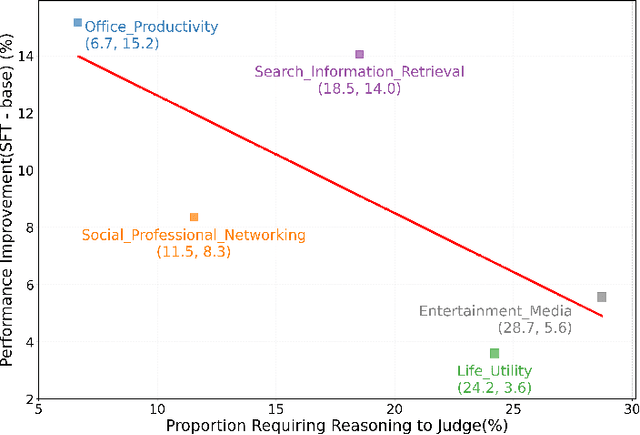
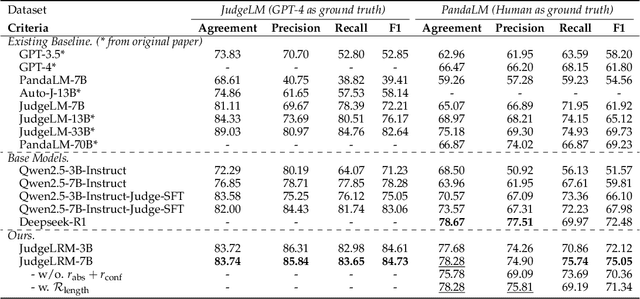
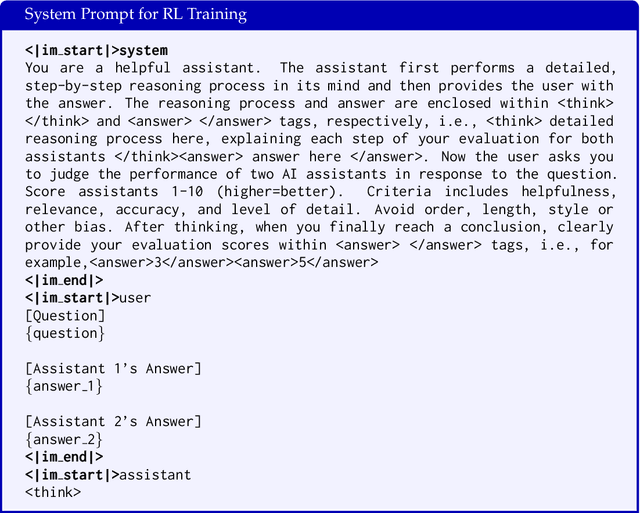
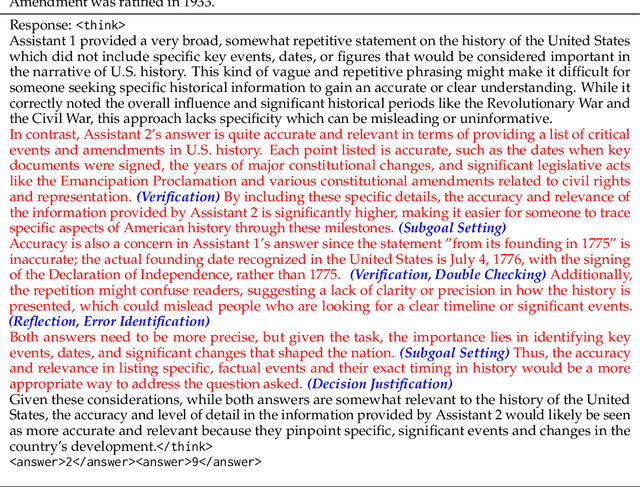
Abstract:The rise of Large Language Models (LLMs) as evaluators offers a scalable alternative to human annotation, yet existing Supervised Fine-Tuning (SFT) for judges approaches often fall short in domains requiring complex reasoning. In this work, we investigate whether LLM judges truly benefit from enhanced reasoning capabilities. Through a detailed analysis of reasoning requirements across evaluation tasks, we reveal a negative correlation between SFT performance gains and the proportion of reasoning-demanding samples - highlighting the limitations of SFT in such scenarios. To address this, we introduce JudgeLRM, a family of judgment-oriented LLMs trained using reinforcement learning (RL) with judge-wise, outcome-driven rewards. JudgeLRM models consistently outperform both SFT-tuned and state-of-the-art reasoning models. Notably, JudgeLRM-3B surpasses GPT-4, and JudgeLRM-7B outperforms DeepSeek-R1 by 2.79% in F1 score, particularly excelling in judge tasks requiring deep reasoning.
Efficient Inference for Large Reasoning Models: A Survey
Mar 29, 2025
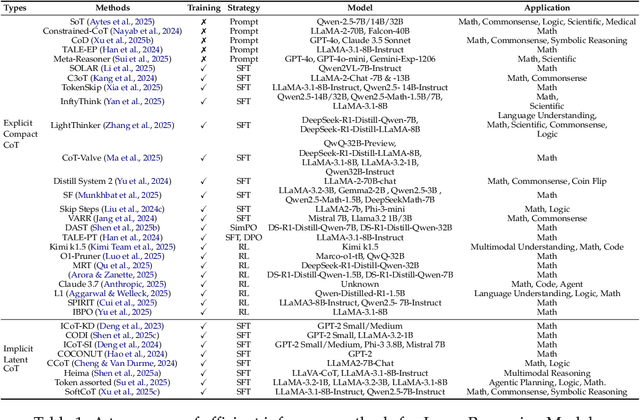
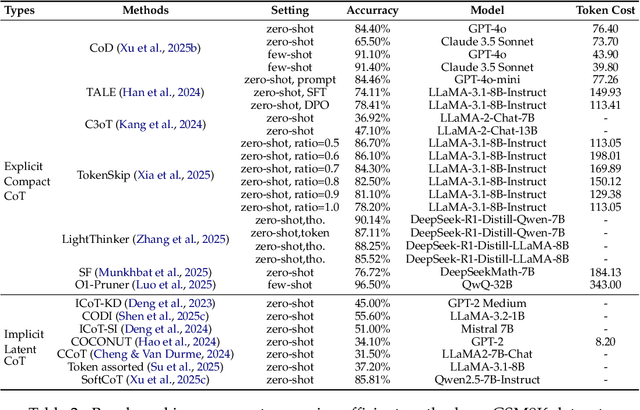
Abstract:Large Reasoning Models (LRMs) significantly improve the reasoning ability of Large Language Models (LLMs) by learning to reason, exhibiting promising performance in complex task-solving. However, their deliberative reasoning process leads to inefficiencies in token usage, memory consumption, and inference time. Thus, this survey provides a review of efficient inference methods designed specifically for LRMs, focusing on mitigating token inefficiency while preserving the reasoning quality. First, we introduce a taxonomy to group the recent methods into two main categories: (a) explicit compact Chain-of-Thought (CoT), which reduces tokens while keeping the explicit reasoning structure, and (b) implicit latent CoT, which encodes reasoning steps within hidden representations instead of explicit tokens. Meanwhile, we discuss their strengths and weaknesses. Then, we conduct empirical analyses on existing methods from performance and efficiency aspects. Besides, we present open challenges in this field, including human-centric controllable reasoning, trade-off between interpretability and efficiency of reasoning, ensuring safety of efficient reasoning, and broader applications of efficient reasoning. In addition, we highlight key insights for enhancing LRMs' inference efficiency via techniques such as model merging, new architectures, and agent routers. We hope this work serves as a valuable guide, helping researchers overcome challenges in this vibrant field\footnote{https://github.com/yueliu1999/Awesome-Efficient-Inference-for-LRMs}.
What Limits LLM-based Human Simulation: LLMs or Our Design?
Jan 15, 2025Abstract:We argue that advancing LLM-based human simulation requires addressing both LLM's inherent limitations and simulation framework design challenges. Recent studies have revealed significant gaps between LLM-based human simulations and real-world observations, highlighting these dual challenges. To address these gaps, we present a comprehensive analysis of LLM limitations and our design issues, proposing targeted solutions for both aspects. Furthermore, we explore future directions that address both challenges simultaneously, particularly in data collection, LLM generation, and evaluation. To support further research in this field, we provide a curated collection of LLM-based human simulation resources.\footnote{https://github.com/Persdre/llm-human-simulation}
 Add to Chrome
Add to Chrome Add to Firefox
Add to Firefox Add to Edge
Add to Edge